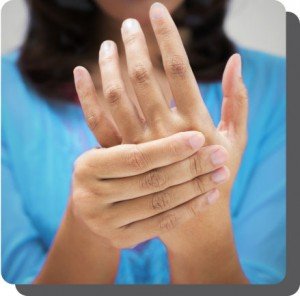MALLET FINGER
A common injury in orthopedics occurring in the hand, mallet finger happens when the extensor tendon has damage at the tip of the finger. The extensor tendon allows the finger to straighten. When damaged, the tip of the finger droops. Although often called “baseball finger”, mallet finger may occur due to a variety of actions or athletics. Commons causes of mallet finger include sporting activities, falling, or work activities. Individuals may also refer to mallet finger using the term “jammed finger”. Mallet finger typically occurs from an object hitting the fingertip and forcing the fingertip to hyperflex.
SYMPTOMS OF MALLET FINGER
Individuals who suffer from a mallet finger injury often feel pain at the affected finger and can see visible swelling and bruising. Visible blood may pool underneath the fingernail. With blood underneath the nail present or a broken or detached fingernail, the individual should seek immediate medical attention. With any type of broken skin, a risk of infection exists. Pooling blood may also indicate a open fracture of the finger.
HOW PHYSICIANS DIAGNOSE MALLET FINGER
While doctors typically do not consider mallet finger a major injury, patients should still seek medical attention from an orthopedic specialist if suffering from finger pain. Getting a medical evaluation can allow a physician to ensure a more serious injury has not occurred.
To diagnose mallet finger, the physician starts with a physical examination. During a physical examination, the orthopedic hand specialist asks the patient about their medical history and inquires about their everyday lifestyle. Next, the physician observes and potentially moves the affected finger to see the range of motion that exists. The “mallet finger test” occurs when a physician asks the patient to straighten their finger on their own. To confirm the diagnoses, the physician uses diagnostic testing. Diagnostic testing can also rule out any torn ligaments, fractures, or other potential injuries to the finger. Diagnostic testing may include Xray, MRI, CT scan or a combination of multiple.
HOW PHYSICIANS TREAT MALLET FINGER
Most mallet finger injuries do not require surgical intervention, However; patients should always seek treatment from an orthopedic physician. Mallet finger injuries that patients leave untreated often result in further injury. The further injury may lead to permanent stiffness and lack of motion in the finger joint.
To treat most mallet finger injuries, physicians use a splint to keep the finger straight until it properly heals. The splint typically only covers the two most distal joints of the finger and patients should wear it for approximately 8 weeks. All physicians may have different protocols so patients should always listen to their treating physician rather than any information they find online.
If the joint of the finger has dislocated or any bones within the finger have fractured, the physician may need to perform surgery on the finger. Surgeons perform surgery to repair mallet finger with the patient under general anesthesia. With a patient under general anesthesia, the patient remains asleep for the duration of the surgery. The type of procedure the surgeon performs depends on the specific injury.
During surgery, the surgeon may need to fuse to joint. The hand surgeon also may need to repair the tendon. To repair the tendon, the surgeon requires a graft. The graft may come from somewhere else within the patients body or from cadaver tissue.
from cadaver tissue.
Following surgery, the physician may or may not recommend the patient to under go physical therapy.
To view a list of all insurances that AOA Orthopedic Specialists accept, click HERE. To schedule an appointment online, click HERE.
DO YOU SUSPECT A FINGER INJURY? CALL 817-375-5200 TO SCHEDULE AN APPOINTMENT WITH AN AOA ORTHOPEDIC HAND SPECIALIST TODAY!
F.A.Q.
What causes a mallet finger?
Mallet finger is usually produced by direct trauma or a strong impact on the fingertip, such as during sports or an accident. It can happen if you forcefully bend your finger, causing the tendon to stretch or tear.
What are the treatment options for mallet fingers?
Wearing a splint or a specifically made mallet finger splint that maintains the fingertip straightened are nonsurgical therapy alternatives. This permits the injured tendon to heal over a period of several weeks. Surgery may be required in some circumstances due to severe injuries or fractures.
How long does it take for a mallet finger to heal?
The healing period varies according to the degree of damage and compliance with therapy. Wearing a splint continually for 6 to 8 weeks usually permits the tendon to mend. Following that, a shorter duration of splinting or finger buddy taping may be advised during specific activities.
Can mallet fingers be prevented?
Mallet finger injuries can be avoided by taking care during tasks that may cause finger trauma, including wearing protective gloves or splints, practicing good technique, and being aware of hand safety.

